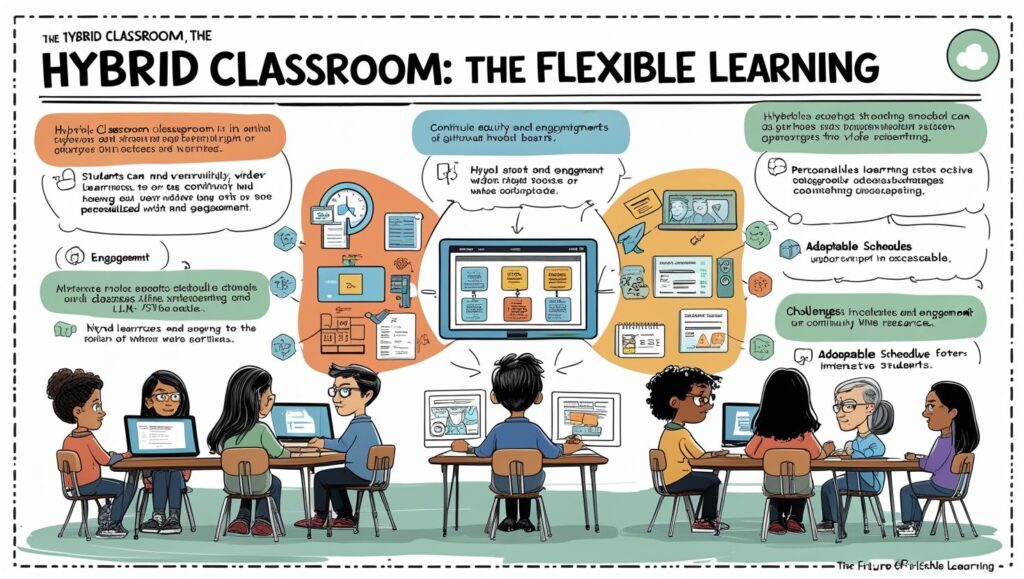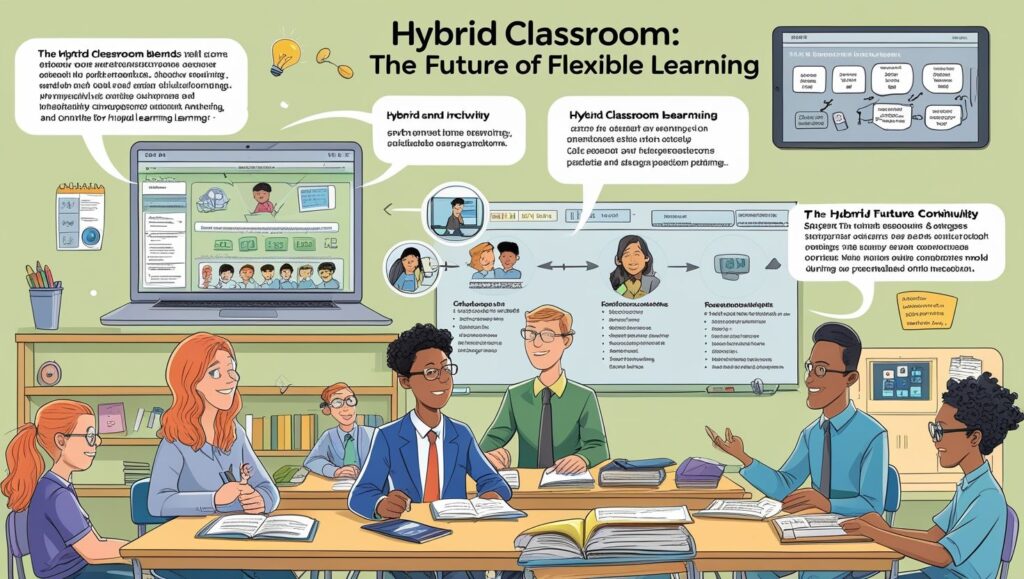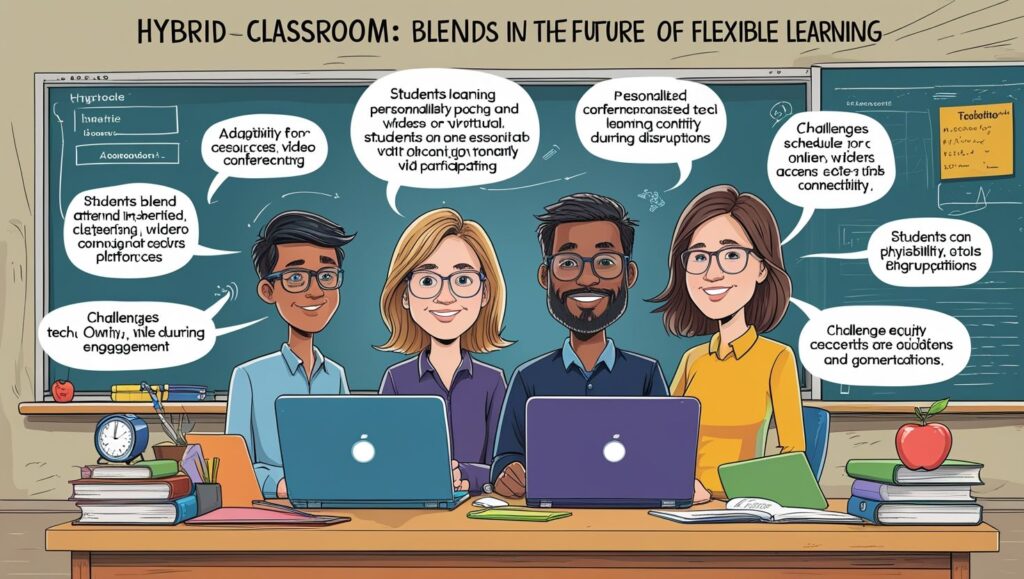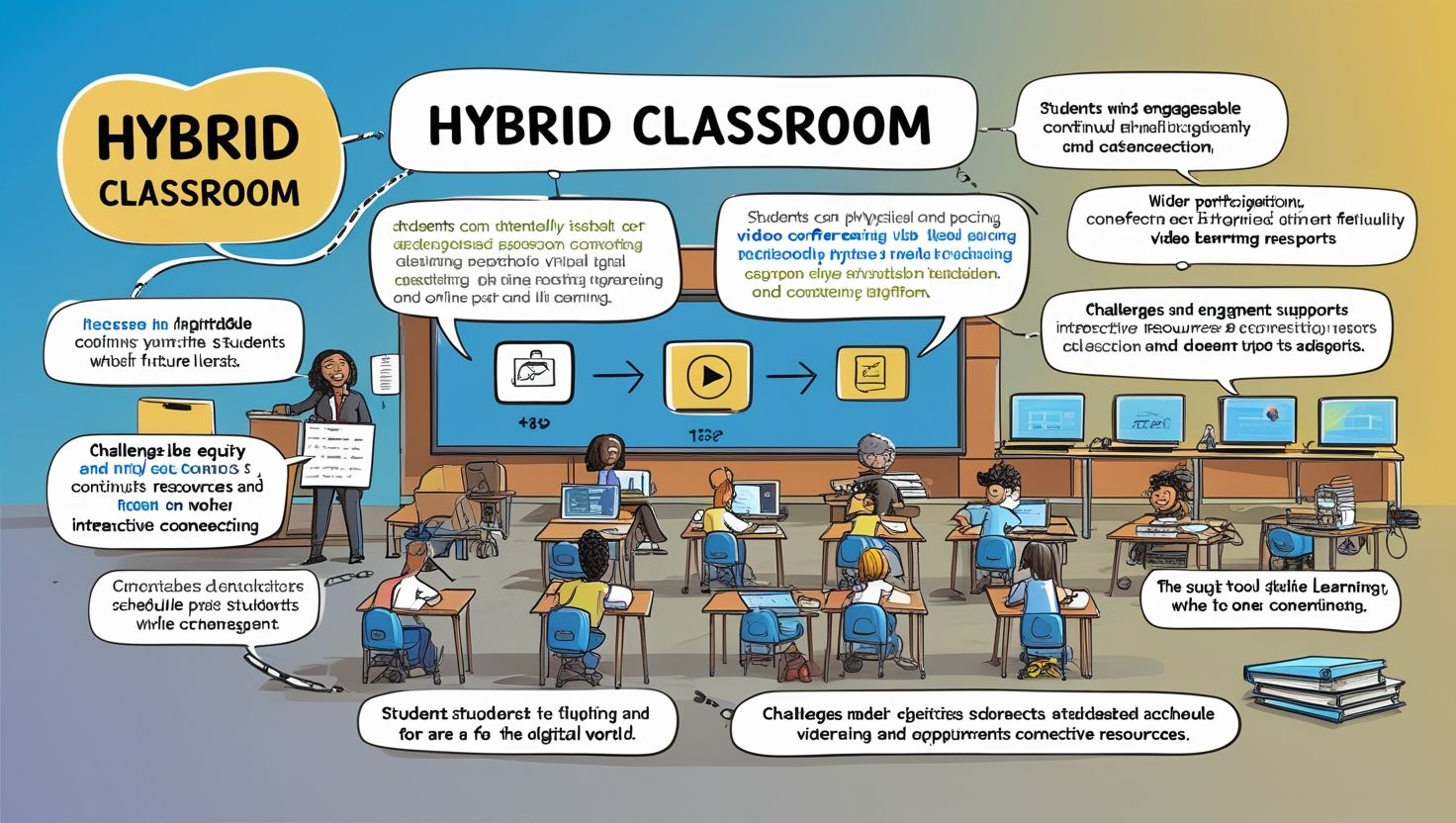1. Introduction
Hybrid Classroom: The Future of Flexible Learning, The hybrid classroom model combines traditional in-person teaching with online learning to create a flexible, student-centered environment. This approach has gained popularity, especially in the wake of the COVID-19 pandemic, which highlighted the need for adaptable education systems. A hybrid classroom enables learners to attend lessons either physically or virtually, depending on their needs and circumstances. It supports synchronous and asynchronous learning, allowing students to engage with course material in real-time or at their convenience.
The model is highly beneficial for institutions aiming to provide continuous learning amidst disruptions. By incorporating both physical and digital teaching strategies, hybrid learning fosters inclusivity and accommodates diverse learning styles. It also helps educators reach broader audiences and enhance resource accessibility. However, implementing a successful hybrid model requires robust infrastructure, teacher training, and strategic curriculum planning. As education continues to evolve, the hybrid classroom presents a sustainable path forward by combining the strengths of face-to-face and online education to meet the demands of modern learners and society.
2. Historical Background and Evolution
The concept of hybrid learning is not entirely new. It began as “blended learning” in the late 1990s when educators started experimenting with combining traditional classroom instruction with online content. Initially, the model was used mostly in higher education and corporate training to offer flexibility and reduce logistical constraints. As internet access and digital tools became more widespread, schools at all levels began integrating online components into their teaching. However, the COVID-19 pandemic served as a major turning point, accelerating the adoption of hybrid classrooms worldwide. What was once considered an alternative became a necessity.
Post-pandemic, many institutions realized the long-term benefits of hybrid education—improved accessibility, cost efficiency, and enhanced engagement. Governments and educational boards began investing in infrastructure, training, and digital platforms to support this shift. The evolution from emergency remote teaching to structured hybrid systems marks a significant transformation in global education. The hybrid model continues to evolve, incorporating new technologies such as AI, VR, and adaptive learning to make classrooms more interactive and student-focused.

3. Components of a Hybrid Classroom
A hybrid classroom functions through a well-integrated set of physical and digital components. Physically, it includes a traditional classroom setup with interactive boards, seating arrangements, and audio-visual equipment. Digitally, it is supported by Learning Management Systems (LMS), video conferencing tools (like Zoom or Microsoft Teams), and digital resource repositories. The classroom must be equipped with high-speed internet, smart cameras, and microphones to ensure seamless delivery to both in-person and remote students. Teachers also use tools such as Google Classroom, Kahoot, or Edmodo to assign tasks, track progress, and provide feedback.
Content delivery is both synchronous (live classes, real-time discussions) and asynchronous (recorded lectures, reading materials, online quizzes). Students require access to devices such as laptops, tablets, or smartphones to participate effectively. Other essential elements include cloud storage for data sharing, collaborative tools like Padlet and Jamboard, and secure assessment platforms. The success of a hybrid classroom relies heavily on the integration of these components, proper scheduling, and constant communication between educators and learners. When well-coordinated, these elements create a dynamic and inclusive learning environment.
4. Role of Teachers in Hybrid Classrooms
In a hybrid classroom, the teacher’s role becomes more multifaceted and dynamic than in a traditional setting. Educators must act as content creators, facilitators, technical troubleshooters, and motivators. One of their primary responsibilities is designing lesson plans that engage both in-person and online learners equally. Teachers must ensure that activities are accessible, interactive, and suitable for a range of learning modes. They also have to manage the digital tools used for communication, assignments, and assessment, which requires ongoing tech competency. Moreover, they need to monitor student participation across both groups, provide timely feedback, and adjust instruction based on real-time analytics.
In hybrid settings, the teacher fosters collaboration among students using digital platforms and manages differentiated learning by leveraging multimedia content. Professional development and continuous training are vital for teachers to stay current with emerging technologies and pedagogies. Emotional support is another critical area; teachers must remain empathetic, ensuring students feel connected and valued, regardless of their location. Ultimately, hybrid teaching demands flexibility, creativity, and an inclusive mindset to meet diverse educational needs.
5. Student Engagement and Participation
Student engagement is one of the key indicators of success in a hybrid classroom. However, maintaining participation in both online and in-person formats requires innovative strategies. Teachers must design inclusive activities that involve both groups—such as breakout sessions, interactive polls, quizzes, and discussion forums. In synchronous sessions, tools like chat boxes, virtual hand-raising, and digital whiteboards encourage active involvement from remote students. For asynchronous learners, assignments can include reflective journals, multimedia projects, and peer reviews. Consistent communication is vital—teachers should maintain regular check-ins via email, LMS announcements, or virtual office hours.
Building a strong classroom community helps foster trust and interaction among students. Encouraging group projects that require collaboration across physical and digital formats promotes peer learning and accountability. Providing timely and constructive feedback further motivates students and helps them stay on track. Importantly, the hybrid model offers autonomy and flexibility, allowing learners to engage at their own pace. When students feel supported and valued in both environments, their participation naturally improves, leading to deeper learning and academic achievement.
6. Benefits of Hybrid Classrooms
Hybrid classrooms offer numerous advantages for students, teachers, and institutions. One of the most significant benefits is flexibility—learners can access education from any location, making it especially useful during emergencies, health issues, or travel constraints. It also promotes inclusivity, reaching students who may otherwise be left behind due to geographical or socioeconomic barriers. The model supports personalized learning, allowing students to progress at their own pace using asynchronous materials. Hybrid classrooms encourage technological proficiency as both students and educators gain hands-on experience with digital tools.
It enables continuous learning, minimizing disruptions caused by school closures or external events. Additionally, it fosters autonomy and responsibility, as students learn to manage their time and learning schedules effectively. For institutions, hybrid education can reduce operational costs, optimize classroom space, and extend outreach. Moreover, the mix of online and offline learning creates a richer educational experience, combining the benefits of face-to-face interaction with the convenience of digital access. Overall, hybrid classrooms align with the demands of 21st-century education, preparing students for modern careers and life-long learning.

7. Challenges and Limitations
Despite its many benefits, hybrid classrooms come with notable challenges. One of the primary obstacles is the digital divide—not all students have reliable access to devices or high-speed internet, which can result in unequal learning opportunities. Teachers may also face technical difficulties during live sessions, causing disruptions in the learning process. Managing two sets of learners simultaneously is complex, requiring additional planning, energy, and adaptability. Student engagement is harder to monitor online, leading to reduced participation or learning gaps.
There are also privacy and security concerns when using digital platforms for classes and assessments. Teachers may experience burnout due to increased workload and the constant demand to innovate. Moreover, not all subjects or activities are easily adapted to the hybrid model; practical, lab-based, or hands-on lessons often suffer in online settings. Institutions must invest in infrastructure, training, and support systems to address these issues effectively. Without adequate planning and support, the hybrid model can widen educational disparities instead of bridging them. Hence, challenges must be met with thoughtful solutions and policy interventions.
8. Assessment in Hybrid Classrooms
Assessment in hybrid classrooms needs to be flexible, fair, and aligned with learning objectives across both environments. Traditional paper-based exams are often not suitable for remote learners, prompting the use of online assessment tools such as Google Forms, Quizizz, and Moodle quizzes. Teachers must design evaluations that account for both synchronous and asynchronous participation, using a mix of formative and summative assessments. Formative assessments—such as discussions, journals, peer feedback, and quizzes—help track ongoing progress, while summative assessments—like projects, presentations, and final exams—evaluate overall learning outcomes.
Teachers should ensure that assessments are authentic, focusing on real-world application rather than rote memorization. Rubrics and grading criteria must be transparent and consistent for both in-person and online students. Plagiarism and cheating remain concerns in online assessments, necessitating the use of proctoring tools or open-book formats that test higher-order thinking. Providing personalized feedback is crucial to help students understand their strengths and areas for improvement. Ultimately, assessment in hybrid classrooms should promote continuous learning, motivate students, and reflect their true understanding and skills.

9. Role of Technology and Innovation
Technology is the cornerstone of hybrid classrooms, enabling seamless interaction between physical and digital learners. Learning Management Systems (LMS) like Canvas, Moodle, and Google Classroom serve as central hubs for sharing materials, assignments, and grades. Video conferencing platforms (Zoom, Microsoft Teams) support real-time lectures and discussions. Interactive tools such as Kahoot, Padlet, and Mentimeter enhance engagement and allow instant feedback. Innovations like Artificial Intelligence (AI) help personalize learning by recommending content based on student performance. Virtual Reality (VR) and Augmented Reality (AR) are increasingly used to create immersive learning experiences in subjects like science and history.
Adaptive learning technologies adjust the difficulty of content based on a student’s progress, promoting mastery at an individual pace. Cloud-based platforms allow collaborative writing, brainstorming, and project work. Teachers also use analytics tools to monitor participation and achievement across both modalities. While technology enhances accessibility and engagement, it must be implemented thoughtfully to avoid dependency or distractions. Proper training and digital citizenship education are essential for both students and educators to harness the full potential of technology in hybrid learning.
10. Future of Hybrid Education
The hybrid classroom model is not a temporary trend but a defining feature of the future of education. As technology advances and the need for flexible, inclusive learning increases, hybrid education is expected to become more widespread across all levels of schooling. Future classrooms will likely integrate AI-powered tutors, immersive simulations, and global learning communities, connecting students across regions and cultures. Institutions will invest more in smart infrastructure, ensuring every classroom is equipped for dual-mode delivery.
Curriculum design will shift toward flexible modules that accommodate both online and offline learners. Education policies will evolve to support hybrid models, including guidelines for assessment, data privacy, and teacher training. More importantly, hybrid education aligns with the UN Sustainable Development Goal 4 (Quality Education for All), enabling lifelong learning and skill development. As digital literacy becomes essential, hybrid classrooms will prepare students not just academically but also for a tech-driven world. Ultimately, the hybrid model offers a scalable, resilient, and student-centered approach that balances human interaction with digital innovation, shaping the future of global education.

Üvezli su kaçak tespiti Ekip çok nazik, evi kirletmeden işi hallettiler. Teşekkürler! https://social.midnightdreamsreborns.com/read-blog/57366
Gençosman su kaçak tespiti Bodrum ve temel kaçakları özellikle yıkıcı olabilir. https://ready.epizy.com/read-blog/175
İstanbul kırmadan su kaçak bulma Çok memnun kaldım, kaçağı bulmak için duvar kırmaya gerek kalmadı. https://mxlinkin.mimeld.com/read-blog/10891
Güzeltepe su kaçak tespiti Beylerbeyi su kaçağı tespiti: Beylerbeyi’nde su kaçağına garantili çözüm. https://vybz.live/read-blog/12852
Esenkent su kaçak tespiti Cihazla tespit yapmaları çok etkileyici, sıfır zarar! https://interactor.pro/read-blog/84763
pattimura4d
Mehmet Akif su kaçak tespiti Kaliteli Ekipmanlar: Kullandıkları cihazlar oldukça profesyoneldi. Sorun tespiti hızlı ve temiz oldu. https://netglu.com/read-blog/11921
aop2xb
760s2k
7q2l9o
Great post, you have pointed out some good details , I also conceive this s a very great website.
7wmbkc
Hello there, I found your web site by means of Google even as searching for a similar subject, your web site came up, it looks good. I’ve bookmarked it in my google bookmarks.
Only wanna input that you have a very decent internet site, I love the layout it really stands out.
Nice post. I learn something new and challenging on blogs I stumbleupon everyday.
It will always be useful to read articles from other writers and use a little something from their
sites.
Thanks a bunch for sharing this with all of us you actually know what you are talking about! Bookmarked. Kindly also visit my website =). We could have a link exchange arrangement between us!
Howdy very cool site!! Man .. Beautiful .. Wonderful .. I will bookmark your web site and take the feeds alsoKI am satisfied to search out a lot of helpful info right here in the put up, we need develop more techniques on this regard, thank you for sharing. . . . . .
whoah this weblog is magnificent i like studying your posts. Stay up the great work! You know, many individuals are searching round for this information, you can aid them greatly.
Have you ever thought about including a little bit more than just your articles? I mean, what you say is fundamental and all. However think about if you added some great pictures or video clips to give your posts more, “pop”! Your content is excellent but with images and videos, this blog could definitely be one of the best in its niche. Terrific blog!
Greetings! Very helpful advice on this article! It is the little changes that make the biggest changes. Thanks a lot for sharing!
Hey! I could have sworn I’ve been to this website before but after browsing through some of the post I realized it’s new to me. Nonetheless, I’m definitely glad I found it and I’ll be book-marking and checking back often!
I’ve recently started a website, the info you provide on this site has helped me tremendously. Thank you for all of your time & work.
Good way of telling, and pleasant post to take facts regarding my presentation subject matter,
which i am going to deliver in university.
My husband and i ended up being very comfortable when Michael could conclude his investigation using the ideas he grabbed through the weblog. It’s not at all simplistic to simply continually be giving away secrets that many some people could have been making money from. And we also fully grasp we’ve got the writer to give thanks to because of that. The main explanations you’ve made, the simple web site menu, the relationships you aid to instill – it’s got most spectacular, and it’s really letting our son and our family reason why the situation is interesting, and that is seriously serious. Thank you for all the pieces!
Thanks so much for providing individuals with an extremely memorable possiblity to read articles and blog posts from this web site. It can be very terrific and as well , full of a great time for me and my office fellow workers to search the blog at minimum thrice every week to find out the latest things you have got. Of course, I am usually satisfied concerning the astonishing methods you give. Certain 3 points in this posting are ultimately the best we have had.
Its good as your other articles : D, appreciate it for putting up.